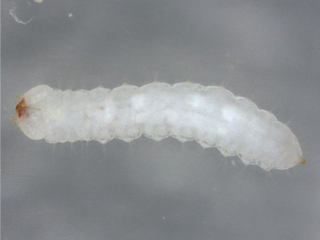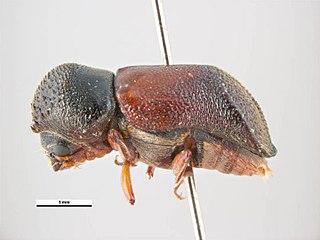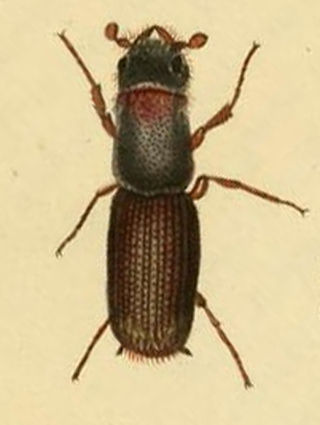
The telephone-pole beetle is a beetle native to the eastern United States and the only living representative of the otherwise extinct family Micromalthidae. Larvae of the beetle live in decaying wood and can be pests to wooden structures, lending them their common name, the 'telephone-pole beetle.'

Bookworm is a general name for any insect that is said to bore through books.

A woodworm is the wood-eating larva of many species of beetle. It is also a generic description given to the infestation of a wooden item by these larvae.

The deathwatch beetle is a species of woodboring beetle that sometimes infests the structural timbers of old buildings. The adult beetle is brown and measures on average 7 mm (0.3 in) long. Eggs are laid in dark crevices in old wood inside buildings, trees, and inside tunnels left behind by previous larvae. The larvae bore into the timber, feeding for up to ten years before pupating, and later emerging from the wood as adult beetles. Timber that has been damp and is affected by fungal decay is soft enough for the larvae to chew through. They obtain nourishment by using enzymes present in their gut to digest the cellulose and hemicellulose in the wood.

The Lymexylidae, also known as ship-timber beetles, are a family of wood-boring beetles. Lymexylidae belong to the suborder Polyphaga and are the sole member of the superfamily Lymexyloidea.

Powderpost beetles are a group of seventy species of woodboring beetles classified in the insect subfamily Lyctinae. These beetles, along with spider beetles, death watch beetles, common furniture beetles, skin beetles, and others, make up the superfamily Bostrichoidea. While most woodborers have a large prothorax, powderpost beetles do not, making their heads more visible. In addition to this, their antennae have two-jointed clubs. They are considered pests and attack deciduous trees, over time reducing the wood to a powdery dust. The damage caused by longhorn beetles is often confused with that of powderpost beetles, but the two groups are unrelated. The larvae of the Cerambycidae are white, straight and generally flat-headed, whereas those of the Bostrichidae are white and C-shaped.

The common furniture beetle or common house borer is a woodboring beetle originally from Europe but now distributed worldwide. In the larval stage it bores in wood and feeds upon it. Adult Anobium punctatum measure 2.7–4.5 millimetres (0.11–0.18 in) in length. They have brown ellipsoidal bodies with a prothorax resembling a monk's cowl.

Hylotrupes is a monotypic genus of woodboring beetles in the family Cerambycidae, the longhorn beetles. The sole species, Hylotrupes bajulus, is known by several common names, including house longhorn beetle, old house borer, and European house borer. In South Africa it also is known as the Italian beetle because of infested packing cases that had come from Italy. Hylotrupes is the only genus in the tribe Hylotrupini.

Ptinidae is a family of beetles in the superfamily Bostrichoidea. There are at least 220 genera and 2,200 described species in Ptinidae worldwide. The family includes spider beetles and deathwatch beetles.

The wharf borer, Nacerdes melanura, belongs to the insect order Coleoptera, the beetles. They belong to the family Oedemeridae, known as false blister beetles. Wharf borers are present in all the states of the USA except for Florida. It takes about a year to develop from an egg to an adult. The name 'wharf borer' comes from the larval stage of this insect, which often lingers on pilings and timbers of wharves, especially along coastal areas. The adult beetles are identifiable via a black band across the end of both elytra. In addition, wharf borers are distinct from other members of the family Oedemeridae due to the presence of a single spur on the tibia of the forelegs and the distance between both eyes. The female beetle oviposits eggs on rotten wood, on which the larvae hatch, burrow, then feed. Adults do not eat and depend on stored energy reserves accumulated as a larva. They are considered a pest because they damage wood used in building infrastructures.

Xylopsocus gibbicollis, common name "common auger beetle", is a species of beetle of the family Bostrichidae.

Neoclytus acuminatus, the red-headed ash borer, is a common North American species in the longhorn beetle family (Cerambycidae).

Cryptotermes brevis is a species of termite in the family Kalotermitidae, commonly known as the West Indian drywood termite or the powderpost termite. It is able to live completely inside timber structures or articles made of wood such as furniture without any outside source of water. It is frequently introduced into new locations inadvertently, and causes damage to the structural timbers of buildings and to wooden objects such as furniture.

Xylosandrus compactus is a species of ambrosia beetle. Common names for this beetle include black twig borer, black coffee borer, black coffee twig borer and tea stem borer. The adult beetle is dark brown or black and inconspicuous; it bores into a twig of a host plant and lays its eggs, and the larvae create further tunnels through the plant tissues. These beetles are agricultural pests that damage the shoots of such crops as coffee, tea, cocoa and avocado.

Platypus cylindrus, commonly known as the oak pinhole borer, is a species of ambrosia beetle in the weevil family Scolytinae. The adults and larvae burrow under the bark of mature oak trees. It is native to Europe.

Dendroctonus terebrans, the black turpentine beetle, is a species of bark beetle native to the eastern United States. Its larvae tunnel under the bark of pine trees, weakening and sometimes killing the trees.

Elateroides dermestoides is a species of ship-timber beetles native to Europe.
Xyloterinus is a genus of typical bark beetles in the family Curculionidae. This is a monotypic genus and the one described species is Xyloterinus politus. It is native to North America where it infests both hardwood and softwood trees, as well as stacks of logs.

Polycaon stoutii, the black polycaon or Stout's branch borer, is a species of woodboring beetle in the Bostrichidae family. It is found in North America in British Columbia, the Pacific Coast states, and Arizona, but has spread elsewhere due to the shipping of wood products.

Arrenodes is a genus of primitive weevils belonging to the family Brentidae, containing a single described species, Arrenodes minutus, commonly known as the oak timberworm. These beetles are pests of hardwoods in North America. Adult oak timberworms are shiny, elongate, and range 7 to 25 mm in length. They are reddish-brown to brownish-black in coloration, with yellow spots on their elytra. Adults display strong sexual dimorphism; females have long, slender, straight mouthparts, while males possess flattened, broadened mouthparts with large mandibles. Males are known to be aggressive and use these large mandibles for combat. These mandibles are also used in courtship. Larvae are elongate, cylindrical, white, and curved. They have three pairs of jointed legs on the thorax and one pair of prolegs near the end of the abdomen.




















